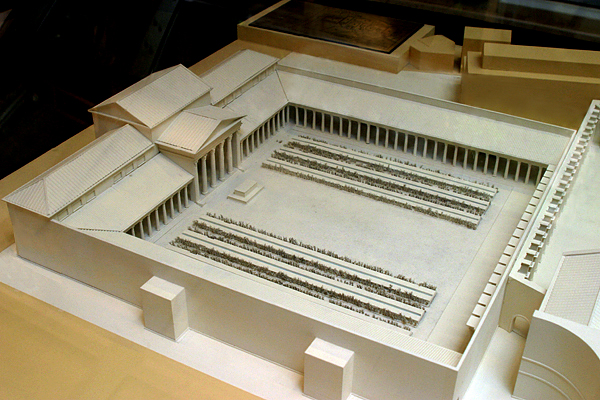
Return to the Forum of Vespasian

"When the triumphal ceremonies were over, as the Roman empire was now firmly established, Vespasian made up his mind to build a temple of Peace. This was completed with remarkable speed and surpassed all human imagination. Not only did he have unlimited wealth at his disposal; he also adorned it with paintings and statues by the greatest of the old masters. In fact, in that temple were collected and deposited all those works that men had hitherto travelled over the whole world to see, longing to set eyes on them even when scattered in different lands. There too he laid up the golden vessels from the Temple of the Jews, for he prided himself on them; but their Law and the crimson curtains of the Inner Sanctuary he ordered to be deposited in the Palace for safe keeping."
Josephus, The Jewish War (VII.5.7)
Considered by Pliny to be one of the three most beautiful buildings in Rome, for Herodian, writing more than a century and a half later, the Temple of Peace was "the largest and most beautiful of all the buildings in the city," and also the richest "since it was adorned with offerings of gold and silver that had been placed there because they were safe" (I.14.2-3). Here were masterpieces of Greek art, including, says Suetonius (Life of Vespasian, XVIII), the Venus of Cos by Praxiteles. Pliny relates that the sculptor made two versions of the statue. The draped figure was purchased by the inhabitants of Cos, who thought it to be a more respectful representation of the goddess. The much more famous nude was acquired by the inhabitants of Cnidus (XXXVI.20). Many pieces looted from Greece and Asia Minor, which Nero had kept in the Domus Aurea, also were displayed (Pliny, XXXIV.84), probably in the porticoes surrounding the courtyard, protected from the elements and framed by the colonnades.
By the sixth century, Procopius could relate that cattle were to be found in the forum.
"for in that place has been situated from ancient times the temple of Peace, which was struck by lightning. And there is a certain ancient fountain before this forum, and a bronze bull stands by it, the work, I think, of Pheidias the Athenian or of Lysippus. For there are many statues in this quarter which are the works of these two men. Here, for example, is another statue which is certainly the work of Pheidias; for the inscription the statue says this. There too is the calf of Myron. For the ancient Romans took great pains to make all the finest things of Greece adornments of Rome" (Gothic War, VIII.21.11-14).
The fragmentary marble bases restored after the fire of AD 192 show that there also was a Hermes by Praxiteles, as well as statues by Polycleitus (creator of the Diadumenos, Doryphoros, and Amazon of Ephesus), Leochares (who is thought to have created the Apollo Belvedere), and Cephisodotus (if the father of Praxiteles, the creator of Eirene).
In the winter of 2005, the original floor of the Temple of Peace was uncovered by Italian archaeologists. Of pink and white marble, the exposed section framed large, closely spaced column bases in the northeast corner of the main hall.
References: Josephus: The Jewish War (1970) translated by G. A. Williamson (Penguin Classics); Procopius: History of the Wars [The Gothic War] (1924) translated by H. B. Dewing (Loeb Classical Library); Herodian: History of the Empire (1969) translated by C. R. Whittaker (Loeb Classical Library).
See also Venus of Cnidus.
![]()